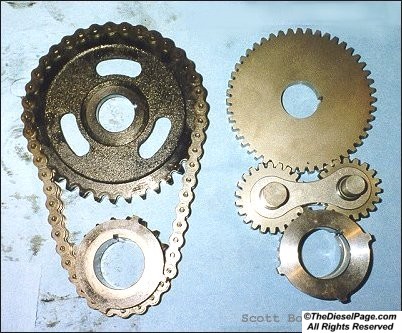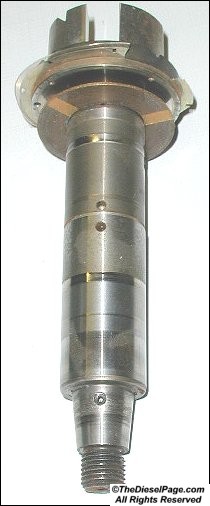Reprint from an article produced here in The Diesel Page in 2003
Chains or Gears?
Which is Best?
6.5 Timing Set Pros & Cons
What are the advantages and disadvantages of using a gear-drive timing set? Let's consider this question, and have a look at some of the related issues involving the 6.2/6.5 gear and chain timing sets.
Three rumors we've heard about the gear-drive timing sets:
#1 "Gear-drives contribute to broken crankshafts."
Reality: A defective elastomer in a harmonic damper or torsional dampening crank pulley can result in a broken crankshaft. A broken cylinder block can result in a broken crankshaft. A defective flywheel or flexplate can result in a broken crankshaft. Knowledgeable mechanical engineers all agree that the purpose of the crankshaft mounted harmonic damper is to reduce harmful torsional vibrations that can and will fracture crankshafts if not controlled.
(Added 6/1/09) Our own 6.5TD Power Project engine ran normally with a DSG gear drive timing set for more than 250,000 miles before it was sold in 2006. I believe weak cylinder blocks and/or defective dampers, pulleys or flywheels are the cause of broken crankshafts. Whether or not an individual vendor recommends a gear drive for the 6.5 depends on whether they sell it. It's that simple. The Diesel Page doesn't sell the gear drive nor does it sell any other part for your truck. The best and most reliable information is what we're interested in.
#2 "The front end of the idler gear axle shafts rub destructively on the aluminum timing cover."
Reality: When a gear drive timing set has been installed correctly, 6.2/6.5 engines that have been disassembled after running hundreds of thousands of miles all show that axle shaft rubbing on the aluminum front cover is of no concern.
#3 "Gear-drive timing sets are noisy."
Reality: My hearing might not be what it used to be, but after listening to at least a couple dozen 6.2/6.5 engines that were equipped with a DSG gear-drive, I have yet to detect any gear noise. The timing and camshaft advance produced by a gear-drive usually result in a more crisp combustion rattle. This should not be confused with gear noise. Whether or not one can detect any gear noise, it is just a small and insignificant contribution to the overall noise level produced by a running 6.2/6.5 diesel engine. You can hear the gear drive if you remove the oil filler cap on a running engine. I can't hear it otherwise.
The factory original 6.5 timing chain set shown above produced about 5/8" (.625") of chain slack. The GM maintenance manuals specify a maximum of .800", while most new chains produce about .250" to .500" of chain slack. GM specifies .500" of chain slack as the maximum acceptable limit for a brand new chain. Obviously, there is a lot of variability.
The 5/8" of chain slack shown in this photo produced about 3 degrees of crankshaft rotation before the gear bolted to the injection pump would begin to move (this equals approximately 3 crankshaft degrees of slop in the timing set). A chain with approximately .250" of slack produces about 2 degrees of crankshaft rotation, and a worn-out chain with .800" of slack will produce 4 degrees or more.
The various timing gear sets I've installed have all produced approximately 2 degrees or less of crankshaft rotation, which in contrast to a chain, will change very little throughout the life of the engine. The primary advantages of a gear-drive timing set are: lower mass, built-in cam and injection pump advance (power & fuel economy improvements), more accurate fuel injection timing for the life of the engine with little to no change over time and miles (unlike a timing chain).
Member Scott Boelman made the following report after installing a DSG Phazer gear-drive timing set:
- "I carefully calculated my fuel economy during the 1588 miles prior to installing the Phazer kit. During this time, my truck averaged 16.9 mpg. In the 1758 miles since the installation, my fuel economy has improved to an average of 17.4 mpg. This is a 3% improvement in fuel economy. Driving conditions were similar for both test periods, primarily highway driving at 70 to 75 mph.
- Power runs using full throttle can provide a good measure of engine power changes. However, acceleration testing a manual transmission equipped truck presents a slight problem in reproducibility. Minor changes in technique from one run to the next could produce big changes in elapsed time. To minimize driver error I ran the acceleration tests in 5th gear from an indicated 45 mph to 75 mph (similar to a passing acceleration test). Prior to the installation, a series of 45-75 mph 5th gear acceleration runs produced an average of 17.41 seconds. Following the Phazer installation, the average elapsed time was reduced to 16.96 seconds. This is an improvement of 0.45 seconds and translates into a 2.7 percent faster time."
The 1982-84 6.2L diesel engines were equipped with stamped steel V-belt crank pulleys. GM introduced a torsional dampening crank pulley in the 1985 model-year in an effort to improve belt life and improve belt-driven accessory life. Anyone who has tried to keep V-belts on the 1982-84 6.2L engines know that unless kept exceedingly tight, wild gyrations are seen in the belts at idle or low engine speeds. Belt resonance is due to cylinder power impulses, which causes the crankshaft to slow down during each compression stroke, then accelerate on each power stroke.
The same sort of harmonic resonance can occur with a loose timing chain. Resonating timing chains can cause all sorts of trouble. Aside from making it more difficult to accurately set the injection timing, loose timing chains can also result in sheared DS4 drive-head shear pins and loosened camshaft bolts - all due to high momentary torque loads caused by loose and resonating timing chains.
The above image shows a mainshaft that had been removed from a DS4 electronic fuel injection pump. This pump (that the shaft was in) was pulled from service because the drive-head (pinned and bolted to the forward end of the shaft) had sheared the pin, and had begun rotating independently of the DS4 shaft. Obviously, the engine can't run when this happens. Aside from this shaft, I witnessed another occurrence of this problem at our local Chevy dealership a few years ago. The drive-head on that DS4 had sheared the pin and was somewhat loose on the pump shaft.
Beginning about 1996, GM upgraded the cam bolt to a grade-10, and nearly doubled the camshaft bolt torque from 65 ft/lbs to 125 ft/lbs. A thread locking sealant is also now specified for the cam bolt, to help prevent it from loosening.
The questions that beg an answer is why did these DS4 drive-head pins shear, and why did GM increase the camshaft bolt torque from 65 ft/lbs to 125 ft/lbs? One possibility is that loose timing chains can cause a harmonic resonance that creates high momentary torque loads on the cam and injection pump, resulting in sheared DS4 drive-head pins and loosened camshaft bolts.
If a gear-drive timing set added torsional or impact stresses to the timing set and crankshaft, the problem with loose camshaft bolts and sheared injection pump drive-head pins would increase in frequency. As of 2006, our gear-drive equipped 6.5TD Project engine had accumulated over 250,000 miles without a problem of any kind, even though the camshaft bolt in this engine was torqued at the originally specified 65 ft/lbs.
Depending on where you shop, a new chain/sprocket set could cost between $75 and $125. On the other hand, a gear-drive costs ~$250 (mechanically injected 6.2/6.5) to ~$350 for a Phazer gear-drive set made to operate with the electronic 6.5 fuel injection system. A gear-drive makes the most sense for the enthusiasts among us or for anyone who traditionally keeps the same vehicle for several years. If you tend to trade vehicles every 2-3 years, then a chain-drive timing set would make the most sense.
TDP










 Reply With Quote
Reply With Quote











